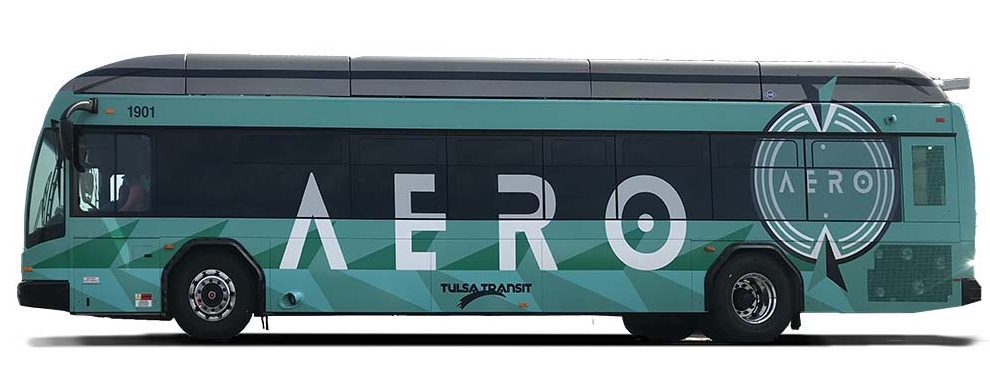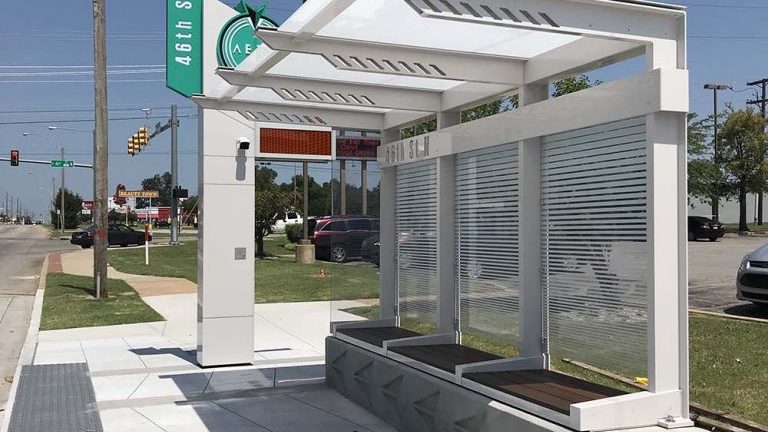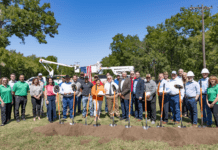Getting up and down Tulsa’s bustling Peoria Avenue by bus should become quick and comfortable as the city moves forward with an innovative rapid-transit system.
Every 15 minutes, a bright turquoise bus emblazoned with the name Aero – an homage to Tulsa’s aeronautic history – will pull up to one of 50 stops along the street. The route stretches 12 miles from 54th Street North to 67th Street South.
That scenario is a far cry from Tulsa’s traditional bus system, where riders can experience 45-minute wait times and lengthy commutes.

“Tulsa will be among the first cities in the United States to operate bus rapid-transit lines, connecting Tulsans to jobs, educational opportunities and destinations in a way they never have been before,” Mayor G.T. Bynum says.
The regular Peoria Avenue bus route carries more passengers than any other in Tulsa, so it was a natural choice for the first leg of the Aero rapid-transit service.
The demographics are also telling; one in seven Tulsa residents live within 10 minutes of Peoria, and one in five people work within 10 minutes of the roadway, Tulsa Transit officials say. The busy street cuts through or near vibrant districts like Brookside and Cherry Street and is lined with shops, restaurants, schools and other businesses.
Liann Alfaro, planning and marketing director for Tulsa Transit, says the Aero system will use a transponder to reduce stops at traffic lights.
“The Transit Signal Priority will hold the green light for 12 seconds longer,” she says. “This will help the buses move through the intersections easier and will help keep the bus on time. We hope to … include a mobile-ticketing option soon after the rollout, which will also help keep the bus moving.”
Aero riders can use regular buses to connect to other destinations not far from Peoria Avenue, such as downtown’s BOK Center, the Pearl District, Oral Roberts University or Tulsa Community College’s Northeast Campus.
Aero will run every day, with weekend wait times at 20-25 minutes. Alfaro says nine buses will run during peak business hours and seven at other times.
The Aero line will have two types of bus stops. The larger ones will feature sheltered seating, real-time arrival signs, bike racks and platform-level boarding for ease and accessibility. Seating at smaller stops will be limited, but riders will get real-time arrival information. Aero buses include Wi-Fi and charging stations, and run on natural gas.
The bus rapid-transit service is a part of a long-term plan to move Tulsa from its traditional vehicle-centric focus to an expanded system with multiple transportation choices. In addition to additional bike lanes and walkability initiatives, Tulsa has welcomed several electric scooter rental companies to provide another layer of transportation for residents and tourists.
The greater number of transportation options could draw young professionals to Tulsa because of their concern with the environmental impact and personal cost of driving automobiles.
“As our organization works to attract and retain young creative talent to Tulsa, we know public transportation is critical to our efforts,” says Maggie Hoey, executive director of Tulsa’s Young Professionals. “Young people want to live in a community that doesn’t always require a car. The new Aero service makes big strides in that direction.”
The city used about $20 million in Improve Our Tulsa and Vision Tulsa funding to build Aero’s infrastructure. Next year, the city estimates it will spend $3.3 million to operate the route. Alfaro says the route does not have a firm launch date, but Tulsa Transit aims for “late fall, early winter. It all depends on the completion of the stations.”
After the Peoria route becomes viable, the plan is to start an Aero route along iconic Route 66.
“The new Aero bus rapid transit system will transform the way residents and visitors can get around our city and will help create a world-class transportation system in Tulsa,” Bynum says.



























